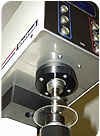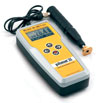
Hardness testing is an important part of quality and many factors need to be considered for this type of test, as seemingly small factors-thickness, size, location-can have a big impact.
Selecting hardness testing equipment for an application can be a complicated decision, as equipment runs the gamut, from benchtop instruments to portable products. Consider the conditions of the application, and of course, the budget. Finally, the equipment is only as good as the operator, so an understanding of basic hardness testing concepts can go a long way in achieving accurate and repeatable results.

This handheld device measures hardness on small, large, flat, round, thin or thick workpieces. Source: Phase II
Trends
“As far as changes in hardness testing, standards have been one source of change,” says James E. Blair, marketing manager at Newage Testing Instruments (Southampton, PA). The ASTM E18-2007 standard has made changes with indenters, calibration routine and requires more work from people, Blair says. (See the accompanying article, “Rockwell Standard Revealed” on page 34.)Besides accommodating the standard, Blair says that Newage has been making a lot of semi-customized testers, units that are adapted for specialty applications. Customers may know that they want something more automatic and Newage can provide a customized product.
While Newage may be running into more of these types of applications, Blair says specialized equipment is nothing new.
“Everybody has always done semi-custom things,” Blair says. “Companies are working very hard to reduce labor costs to do their testing as automatically as they can. Quality control is one area where they feel they can stand out.”
If testing takes too long, though, it may become an added cost, Blair warns.
Customers always want to further reduce the cost of testing, thus testers are uniquely adapted for inline testing, says Blair. Their testers are designed so that they can test deflection, or movement, under load, he says.
When testing high-volume applications containing dirt and build up, or imperfect conditions under high-volume, that is where Newage testers can shine, Blair says. Even when testing in poor environments containing dirt and vibration, the Versitron Rockwell tester can compensate for the effects of a bad environment. It can be used for a variety of applications, including testing large diameter pipe, large forgings and automotive parts that cannot be lifted by hand.
Though Newage does offer instruments for laboratory testing, Blair says the testers are most commonly used for factory-floor testing. Thus, the testers can adjust to dirt and other conditions that can upset a test result.
“The testers are measuring at the micron level so you can imagine what would happen if a tiny amount of dirt got underneath them,” Blair says.
“Field testing and shop floor testing can be completely different animals,” Blair says, “especially a heat treat shop, with a lot of dust in the atmosphere and air-borne contaminants.”

The Starrett No. 3817 Automated Digital Hardness Testing System includes preset dwell times and automatic cylindrical correction for hardness value to comply with ASTM-18 tolerances. Source: Starrett
Equipment
In light of the standards, Instron (Norwood, MA) has some suggestions in dealing with the changes. First, review your processes to bring them up to the new requirements, and review your test blocks and indenters to see if they meet the new standards. Carefully decide if you want to work to the new standards or stay with the old versions. Also, coordinate the timing of your changeover from the old to new standards.United Testing Systems (Huntington Beach, CA) also is no stranger to hardness testing. Since 1984, the company has manufactured computer-controlled closed-loop Rockwell testers and their second generation Rockwell tester, the Tru-Blue II closed loop tester. The tester comes standard with a direct certification of the hardware calibration with NIST traceability and a one-year indirect calibration for customer-specified hardness scales. It can be used without an initial on-site calibration, and it can be moved to a new location without having to be re-calibrated. When mounted on an optional mobile stand, the Tru-Blue II becomes portable for use in different departments.
“Basically, we try to do an all-in-one testing,” says Product Manager Phil Eusebi, who has been with the company for 23 years.
The Tru-Blue is not the only hardness testing product United offers, however. Along with the Tru-Blue, United has a line of hardness testing accessories, including Rockwell, Brinell and micro hardness test blocks; Rockwell diamond indenters, scales A, C and N; heavy load Vickers and micro hardness diamond indenters; carbide ball indenters; anvils and support devices; along with 2-inch roll mini serial and parallel printers, stationary and mobile stands.
While there have been minor changes in hardware and software, Eusebi says that the product has stayed the same for the most part. “That’s why we can keep the price down,” Eusebi says.
However, the latest revision of the standard may cause changes for some, he says.
“The latest revision made it easier for companies to certify their equipment or have equipment certified,” Eusebi says. However, he says it did make it tougher for companies with “dinosaur machines,” those around 40 or 50 years old. Because the government uses new closed-loop load cell machines in setting the standard, it may be more difficult to get older machinery certified, Eusebi says.
Using old dial machines may work for small jobs not concerned with aerospace equipment, but the machines eventually may be difficult to use.
“They get old,” Eusebi says. “It’s like an old watch, sometimes when it’s supposed to move, it doesn’t.”
Not only that, but old machines are more often subjected to operator influence. But with closed-loop, motorized computer-controlled machines, a computer controls how long loads are applied.
Taking away operator influence is a big advantage for many companies.
“Our nose clamp is probably one of those things that sells a lot of machines,” Eusebi says.
Machines are so accurate that results can be skewed if an operator has his hand on the part. The clamp is there to hold the oversize or oddly shaped parts. Thus, the machine is hands-free and the operator has to push the test button.
The company’s products are used for brake pad manufacturers, heat treating, tubes, pipes and test labs, “wherever they need to test that material,” Eusebi says. Besides these, he says they also have received some unusual requests, such as an armor piercing material.
Phase II (Carlstadt, NJ) has a portable Ultrasonic Hardness Tester, Model No. MET-U1A. This handheld device allows the measure of hardness on small, large, flat, round, thin or thick workpieces, according to Phase II’s Neil Glitter. This IP66 dust/waterproof unit is capable of testing softer metals such as copper and brass as well as the typical hard metals and alloys while adhering to the strict ASTM A1038-05 guidelines for portable hardness testing using UCI method.
The nondestructive feature allows accurate testing on delicate or finely finished surfaces without physical or structural damage to the operator’s part, consquently saving cost and time for refinishing or replacing damaged parts.
This new gage can easily convert and be calibrated to all the popular hardness scales such as, HRC, HRB, HRN, HRT, HB and HV. It has output to PC via USB interface.
Regarding the new ASTM specification, Glitter says, “Phase II believes the latest E18-07 standard shouldn’t affect most hardness testing in the market, but will certainly assist in weeding out older models that are far and away out of international tolerances.”
The No. 3817 automated digital hardness testing system from The L.S. Starrett Co. (Athol, MA) provides accuracy, reliability and performance in demanding applications. The system is capable of measuring all Rockwell, Rockwell Superficial, Vickers and Brinell Scales and meets or exceeds all major industry standard requirements including those for ASTM, ISO and direct NIST traceability.
According to Scott Robinson, technical support manager at Starrett, the ASTM E-18-07 standard should force the use of closed-loop testers and elimination of old style analog or weighted devices.
The 3817 system offers precision and ease-of-use via a one-touch automated testing operation that requires minimal operator involvement. For easy viewing, hardness numbers are displayed from 1 to 1/100thpoint on a brightly illuminated digital control. To comply with ASTM E-18 tolerances, the No. 3817 system provides preset dwell times and automatic cylindrical correction. The system provides built-in electronic conversion charts for cross-referencing hardness scales and approximating tensile strength, eliminating the need for mechanical or electronic adjustments.
Advanced features include closed-loop NTEP load cell technology that improves repeatability and efficiency, and removes the need to use the conventional weights method. The system includes a rigid, modular base assembly, RS232 output and a detachable clamping device for oversized or irregular parts. A self-contained head assembly is adaptable for special applications. Additional features include upper and lower limits alarms and a fitted tray for indenters and anvils. The Starrett No. 3817 Automated Digital Hardness Testing System supports minor loads of 10 kilograms, superficial minor loads of 3 kilograms, major loads of 60, 100 or 150 kilograms and superficial major loads of 15, 30 or 45 kilograms.
Even though the invention of the Equotip technique at Proceq SA (Aliquippa, PA) dates back to 1975, the basic idea of portable hardness testing still gives much leeway for fast-paced innovation and practical product advancement.
Portable rebound devices employ the dynamic Leeb method (originally invented by Proceq), which compares the impact and rebound velocities of an impact body that is propelled against the sample material. Proceq’s Equotip family works for a wide range of applications.
In 2005, the company released the basic HRC tester, the Equopen. In 2006, Proceq rolled out the modern one-hand design of the Equotip Piccolo. And in 2007, Proceq showcased the Equotip 3 and the fully-integrated Equotip Bambino to attend the customers’ latest applications of metal hardness testing.
By offering the Equotip Bambino, Proceq meets the requests to provide the Piccolo’s testing platform to a wide range of customers. By using the Equotip 3, an advanced level of hardness testing on metals is achieved.
While the standards and product features may change and evolve, whatever the environment-busy shop floor, sterile lab or a combination-there is a hardness testing instrument to fit the application. And if an off-the-shelf product does not suit the application, many companies can provide a customized piece of equipment that will.Q
For more information on the companies listed, visit their Web sites:
- Instron, www.instron.com
Newage, www.hardnesstesters.com
Phase II Machine & Tool Inc., www.phase2plus.com
Proceq, www.proceq.com
Starrett, www.starrett.com
United Testing, www.unitedtesting.com
Quality Online
Visit www.qualitymag.com and type “hardness testing” into the search engine to find related articles. Among the results you’ll find:- “Not So Hard”
- “Versatility in Hardness Testing”
- ”Hardness Testing Gets Up and Goes”
- Quality 101: “Rockwell Hardness Test”
Tech Tips
Purchasing a new Hardness Tester? Eight questions to ask your supplier:- 1. Are the test forces verified directly?
2. Is the depth scale verified directly?
3. Are the test-cycle times precisely controlled?
4. Does the tester meet all of the latest ASTM E-18 changes?
5. Can the supplier provide accredited field service support?
6. Is the tester certified with the new NIST-traceable standards?
7. Can it make tests on oversize parts without the use of a jack rest?
8. Where is the tester manufactured?



